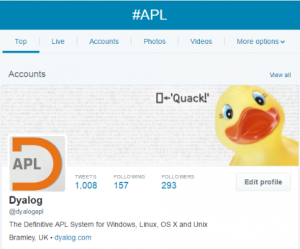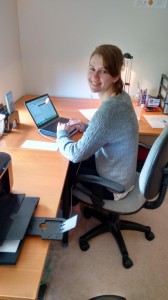#Dyalog16 – Vibeke Ulmann As announced earlier – and iterated many times by yours truly, to media and other interested parties, because it is SOOOOOOO exciting – this year, the Viking Challenge is to drive a speed boat in the … Continue reading
Author Archives: Guest Blogger
The Story of a Summer Intern
by Suki Tekverk
As a born and raised New Yorker, I thought I had seen it all, but two short weeks spent in Vancouver with Roger Hui and his family proved me very wrong! I went from being at the top of the totem pole to one of the most clueless people around. Luckily, these new experiences provoked new paths of thought and ultimately left me more prepared to face the world than I was when my plane shakily landed in this foreign place.
Upon my arrival, I was greeted by Stella, Roger’s wife, and their children, Nicholas and Rachel, who promptly made me a sign for my bedroom door, making me feel right at home.
The next morning, I went right to work, unsuccessfully writing a dfn for the Fibonacci sequence. After struggling for at least 40 minutes, Roger showed me a solution. This solution was nearly the exact definition of the Fibonacci sequence, setting a precedent for the uncomplicated and direct solutions that ensued. Over the next week we ripped through a Monty Hall simulation, recursive Peano addition and multiplication, recursive and non-recursive binomial coefficients, the Cantor set, the Sierpinski Carpet and more. Over this week, I not only discovered new realms of mathematics but also ate foreign food, hiked through a canyon, watched a Chinese film, made cookies, went to a horse ranch, listened to an orchestra performance, experienced sugar withdrawal and saw a sunset on a mountain. This was just the first week.
The main focus of week two was proofs. At first, I was skeptical of the value of writing proofs in APL as opposed to writing them on paper, but being able to run each step of the proof was quite useful. I started with proof by induction, then by contradiction. After learning the basics I proved the sum of an arithmetic series, sum of geometric series, sum of integers, sum of odd integers and sum of binomial coefficients. This week showed me how closely APL and mathematical notation align. However, I am still annoyed by the fact that the order of operations isn’t how I learnt it in school; it will take some getting used to. My next task will be buying a Windows computer for APL.
Overall, these two weeks in Vancouver were a great learning experience on many levels. Coding in APL has led me to consider possible career options as well as help me understand the nature of the language. Living in a city so far away from home made me question things I considered commonplace and forced me to realize that New York is only a small part of a much larger world.
It’s APL…but not as we know it!
by the Dyalog Duck
 As the party behind Dyalog’s Twitter account I often search our feed for #APL or just APL to see if anyone is talking about us or APL in general and I am frequently surprised by what pops up. We have often had a giggle in the office over some of the things we find and it was suggested to me that others might find these interesting too hence this rather random blog post.
As the party behind Dyalog’s Twitter account I often search our feed for #APL or just APL to see if anyone is talking about us or APL in general and I am frequently surprised by what pops up. We have often had a giggle in the office over some of the things we find and it was suggested to me that others might find these interesting too hence this rather random blog post.
 Probably the most well known alternative APL is the container shipping and ocean freight company American President Lines (@APLShipping). The Dyalog staff often stand at the railway crossing on our way to the village bakery for lunch and chuckle at the APL containers whizzing past on the train … we are easily amused!
Probably the most well known alternative APL is the container shipping and ocean freight company American President Lines (@APLShipping). The Dyalog staff often stand at the railway crossing on our way to the village bakery for lunch and chuckle at the APL containers whizzing past on the train … we are easily amused!
 My personal favourite other APL has to be Athletic Propulsion Labs (@APLrunning) with their ‘oh so gorgeous running shoes’ … their trainers are things that I desire on a daily basis!! For you non-shoe lovers out there, they are also the official footwear supplier for the Renault Sport Formula One team.
My personal favourite other APL has to be Athletic Propulsion Labs (@APLrunning) with their ‘oh so gorgeous running shoes’ … their trainers are things that I desire on a daily basis!! For you non-shoe lovers out there, they are also the official footwear supplier for the Renault Sport Formula One team.
 The APL alter-ego that comes up most frequently in my Twitter search is a musical one … it seems we also share #APL with a 4 member boyband from South Korea. This APL (@APL_world) is extremely popular with teenage girls from Japan and Korea who frequently tweet their undying love for the boys … it makes you wonder who thought it was a good idea to name a teenage pop sensation after a programming language!
The APL alter-ego that comes up most frequently in my Twitter search is a musical one … it seems we also share #APL with a 4 member boyband from South Korea. This APL (@APL_world) is extremely popular with teenage girls from Japan and Korea who frequently tweet their undying love for the boys … it makes you wonder who thought it was a good idea to name a teenage pop sensation after a programming language!
Still in the musical world we also have an uber cool APL namesake in rapper apl.de.ap (@apldeap) who is also one of the founding members of the Black Eyed Peas.
 Another APL that we are proud to share #APL with is the John Hopkins University Applied Physics Laboratory (@JHUAPL) in Maryland USA. NASA’s Juno spacecraft successfully entered Jupiter’s orbit in July carrying an instrument suite that includes the Jupiter Energetic Particle Detector Instrument (JEDI) built by the Johns Hopkins Applied Physics Laboratory. APL in space … how cool is that!
Another APL that we are proud to share #APL with is the John Hopkins University Applied Physics Laboratory (@JHUAPL) in Maryland USA. NASA’s Juno spacecraft successfully entered Jupiter’s orbit in July carrying an instrument suite that includes the Jupiter Energetic Particle Detector Instrument (JEDI) built by the Johns Hopkins Applied Physics Laboratory. APL in space … how cool is that!
 The Association of Professional Landscapers (@The_APL) are the APL that fill my screen with greenness, tweeting some amazing photos of their garden and landscaping projects.
The Association of Professional Landscapers (@The_APL) are the APL that fill my screen with greenness, tweeting some amazing photos of their garden and landscaping projects.
 Finally, if you are having a bad day and just need cute puppies and kittens to coo over, the Animal Protective League (@APLSpringfield) in Springfield USA is the perfect APL for you. As well as providing cuteness overload they also do a great job re-homing animals in need.
So there you go folks … a few of my favourite alternative APLs for your amusement. Of course there are lots of other APLs out there in Twitterland but frankly most them are just not that interesting … and a few, to spare your blushes, are just not the sort of thing we want to share!
Finally, if you are having a bad day and just need cute puppies and kittens to coo over, the Animal Protective League (@APLSpringfield) in Springfield USA is the perfect APL for you. As well as providing cuteness overload they also do a great job re-homing animals in need.
So there you go folks … a few of my favourite alternative APLs for your amusement. Of course there are lots of other APLs out there in Twitterland but frankly most them are just not that interesting … and a few, to spare your blushes, are just not the sort of thing we want to share!
Thursday 25 September at Dyalog ’14
This was originally posted to Catalyst PR’s Facebook page and is reproduced here to make it accessible to people who don’t have Facebook accounts.
For information on the presentations at Dyalog ’14, see http://www.dyalog.com/user-meetings/dyalog14.htm.
On Thursday 25 September we were in for an impressive presentation called School Laser System with NFC Registration and Alerts by Chris “Ziggi” Paul, Laser Learning Ltd (U.K.).
Ziggi has previously developed other applications in Dyalog APL – most notably an ePortfolio-based nursery training solution for the Childcare company (see Dyalog’s case study at http://www.dyalog.com/case-studies/childcare.htm) which won the Nursery Supplier/Innovator 2008 Award at the Nursery Management Today Awards.
Since then the company has grown substantially and have branched out into Carer’s Careers – a company that is focused on training people who work with caring for others – and now the School Laser System with Near Field Communications (NFC).
The background for the School Laser System with NFC is that the principals are now also working with a new Academy free school. The School has 728 pupils, aged 4-11, and they need to be accounted for at all times during the day. The school is located over two main sites and has an external catering hall and a swimming pool. It also provides before-school and after-school clubs and mini-bus services.
The school “LASER” system is designed as a complete communication and information system between parents and school staff; recently it has been expanded to NFC in order to provide teachers and staff with up-to-date, relevant information. Each pupil in the school is issued with an NFC wristband and tags for their bags and key items of the uniform. Staff use NFC-enabled mobile phones or NFC readers connected to PCs to log a pupil at key points, for example, on and off a bus or at the dining hall. The NFC tags let the lunch staff know what food order the parents have requested each day and can give a full itinerary of clubs and school activities. Alerts of allergies or other critical medical information is displayed when a tag is scanned.
Ziggi showed us the parents’ interface to the system, as well as that used by the staff. The security around the system is obviously very high, using encryption and secure log-in. There is no data stored on the wristbands, bag tags or uniform items. If a child has forgotten to bring their wristband, a substitute – which only works for that day – is issued.
I believe that the system has great potential. There is a market not only for other UK infant and junior schools to implement this applications, but catering firms supplying school dinners could also benefit greatly from using this application.
NOTE for readers not familiar with the requirements for UK school staff concerning reporting, tracking, tracing, accounting for, etc. all children at all times – and who may have concerns regarding “big brother” tracking of children’s movements during the time they’re at school or attending after school clubs, etc.: This system is developed for tracking children aged 4-11. The application saves the school staff an enormous amount of admin. Parents love it, and as for issues around data protection, for example, medical information, no data is stored on the items the children carry around (wristband, bag tag or uniform items). It is already common practice that children with allergies and other medical conditions have their own little poster with their picture, age, condition and actions required in case of an incident posted in the classroom and the teacher room.
This is my final post from Dyalog ’14 – see you at Dyalog ’15, which seems to be going in the direction of Italy (TBC).
Wednesday 24 September at Dyalog ’14
This was originally posted to Catalyst PR’s Facebook page and is reproduced here to make it accessible to people who don’t have Facebook accounts.
For information on the presentations at Dyalog ’14, see http://www.dyalog.com/user-meetings/dyalog14.htm.
During Dyalog ’13, Dyalog Ltd announced an agreement with Syncfusion Inc. The agreement stated that Syncfusion’s Windows Presentation Foundation (WPF) and JavaScript libraries would be bundled with Dyalog version 14.0 (see http://www.dyalog.com/news/81/420/Dyalog-Agreement-with-Syncfusion.htm).
On Wednesday the 25th it was, therefore, a pleasure to attend the presentation by Claus Madsen of Fine Analytics (Denmark), where he presented the company’s InRisk Asset Allocation Platform.
The application is written purely in Dyalog and is aimed at professional investors. Fine Analytics have taken advantage of the WPF capabilities and Syncfusion controls available with Dyalog 14.0 to build a generic asset allocation platform with special focus on the professional investor. A specially designed .NET class facilitates the separation of the administrative and analytical sections of the application and a flexible calculation engine that allows a user to define type/structure/order is an integral part of the platform. All assumptions can be controlled from the professional-looking user interface; the user interface can also be used to change/import/construct/delete/add/copy/export a portfolio as well as add new assets in asset groups.
Tuesday 23 September at Dyalog ’14
This was originally posted to Catalyst PR’s Facebook page and is reproduced here to make it accessible to people who don’t have Facebook accounts.
For information on the presentations at Dyalog ’14, see http://www.dyalog.com/user-meetings/dyalog14.htm.
Maintainability
The first presentation I would like to highlight from today’s programme is by Gianfranco Alongi from Ericsson AB (Sweden). Those of you who read my posts from Dyalog ’13 last year will know that I am rather taken with Gianfranco’s approach to software development and, in particular, his insistence that it is a software programmer’s sole mission in life to leave a legacy (in the form of code) that is so simple and easy to understand that anyone who comes in later can pick up the ball and run with it, without having to re-invent the wheel and without risking destroying the application. Work smarter – not harder – is his mantra.
Gianfranco’s talk this year was called Let’s Talk about Maintainability!. The background for the talk is that any professional programmer obviously strives for maintainable code, well aware that an unmaintained codebase gradually transforms from a well-tended garden to a dark haunted forest that requires animal sacrifice if left to its own devices. Far too many systems have “that” piece of code – the unmaintained marsh, the mess that causes nausea and elevated blood pressure. Some people swear developers have lost parts of their souls in there and you can hear screaming if you work late enough for long enough…
During the talk Gianfranco explored some of the underlying mechanics of maintainability, presenting a definition of maintainability based on human cognition and sharing a language that might help when talking and reasoning about maintainability. Ultimately any programmer is responsible for maintaining the codebase; However, software entropy is real and we pay in blood, sweat and tears if we choose to ignore it. He insists – and quite rightly so – that maintainability is economics because the Cost of Change (CoC) goes up and up the longer a projects run and it’s measurable as it leads to smaller margins and ultimately smaller profit. Ultimately, you get to a point where it is no longer viable to throw more resources (more people or more overtime) into the mix, and you simply have to re-architect.
The psychology involved in software programming is fascinating! So is the shift from the days of programmers being proud of their ability to write code that other programmers may have difficulty understanding to a world where simplicity in the coding is the ultimate target – in order to address the increasing complexity in the applications.
Statistics
Stephen Mansour (PhD) has taught Statistics at the University of Scranton (U.S.A.) for the past 7 years. He is also working with The Carlisle Group – a company focused exclusively on creating software to support the fast growing mortgage and asset securitisation industry.
The Carlisle Group’s flagship product is CAS, a Collateral Analysis System highly specialised for global asset securitisation markets and used by participants in all facets of the mortgage business, including investment banks, commercial banks, accounting firms, bond insurers and loan originators.
Stephen’s presentation was named Taming Statistics with Limited-Domain Operators and took its offset in a new statistical package he has developed which is using Acre.
(Acre facilitates code management for APLers and was the subject of another talk today. Acre is available as open source software and can be downloaded for free from http://aplwiki.com/acre).
Asked why he felt there was a need for yet another stats package – after all, there are perfectly good packages available in the market, such as R, and even Excel has 87 stats functions, so what exactly is it that a stats package developed in APL can offer that the others can’t, the answer was: Defined Operators!
Stephen then demonstrated the new stats package by making some assumptions with regards to next year’s user meeting and the likelihood of the venue being over-subscribed (or not) based on a number of assumptions and relations.
The package does take advantage of the fact that R already connects into APL and Stephen ended the presentation by saying that the package is currently in beta. He is happy to share, so if you would like to review/try the new stats package please e-mail (Stephen.Mansour@scranton.edu) and specify whether you would like the R version or the native APL version.


 Follow
Follow